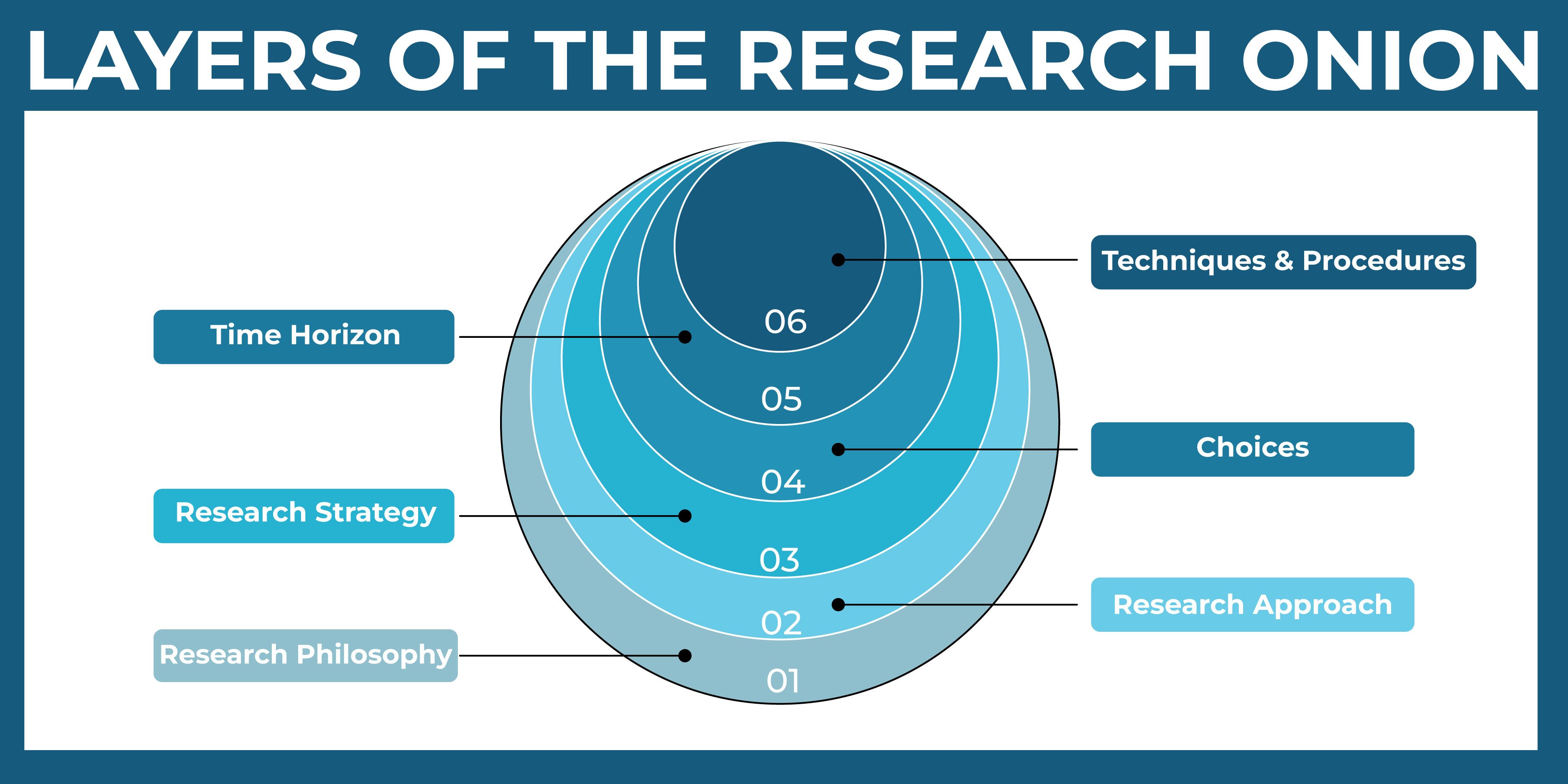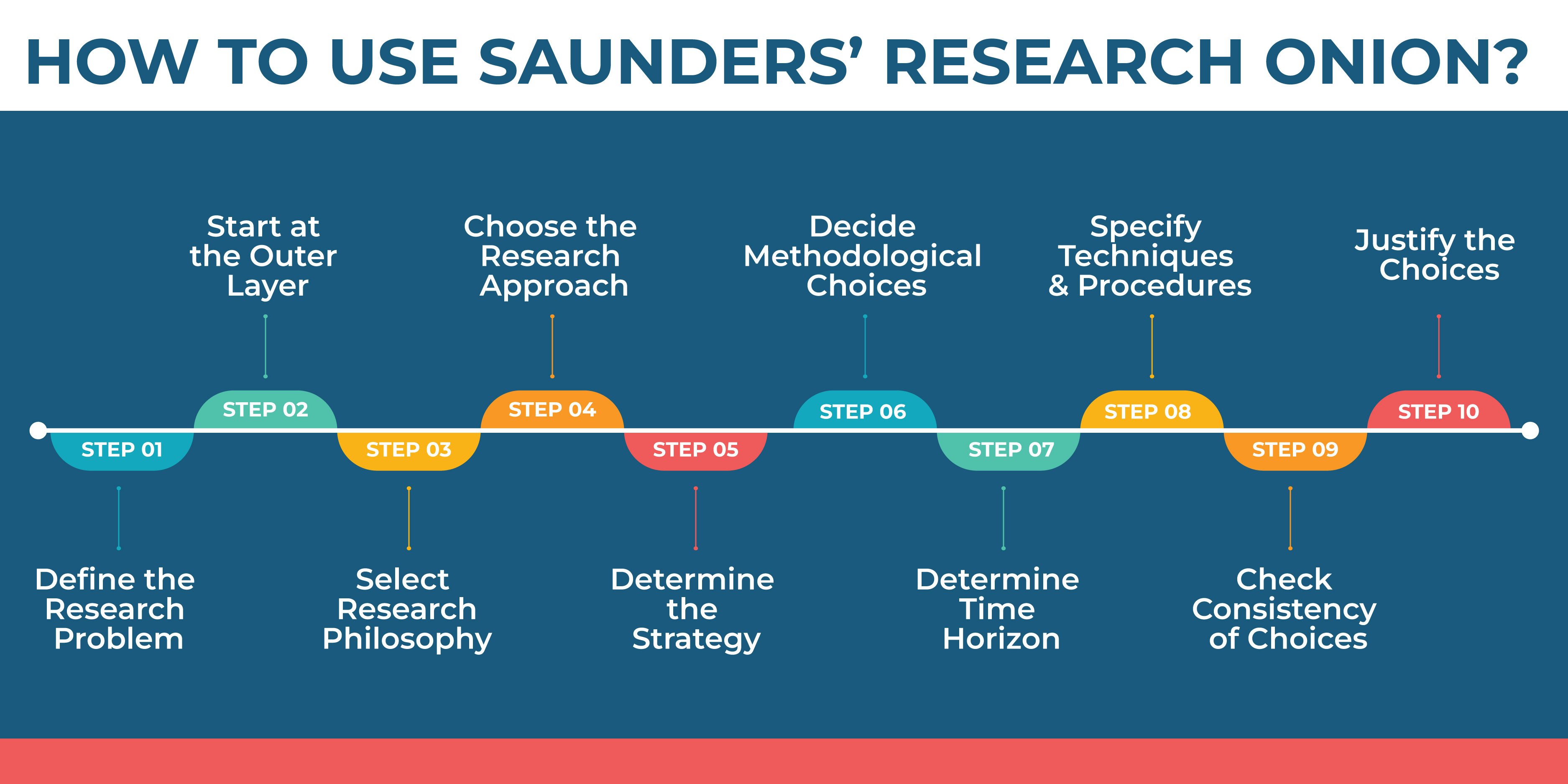Understanding Research Methodology: Saunders’ Research Onion
This blog provides information on the famous Saunders’ Research Onion.
This blog provides information on the famous Saunders’ Research Onion.
Table of Content
What is a Research Onion? A Brief Overview!
What are the Layers of Saunders Research Onion?
While undertaking dissertation prep classes in your programme, you might have noticed the term “Saunders Research Onion”. It is introduced as a research method in many such courses. But what is it, and what are its uses and its importance? This blog aims to answer these questions and more.
The onion approach to research is popularly known as Saunders' Research Onion. It was developed by Mark Saunders et al. (2007). This is a conceptual model designed to help and guide researchers through the process of developing a well-structured approach or methodology. It ingeniously uses the metaphor of an onion to explain how research is a constant peeling of layers (the questions being answered) until you reach the root or the solution.
The central purpose of the Research Onion Model is to help the researcher develop an approach or methodology to continue their research. It involves assisting the researcher throughout the different stages of research, from the philosophical foundations to specific techniques used for collecting data.
What is the significance of the onion? The points below shed some light on this topic:
Structured Approach: Provides a structured or organised way to think about and document the many decisions one needs to take while performing research
Logical Progression : The multiple layers of the onion model represent a logical progression of decisions, starting with the most abstract to the most concrete or practical
Holistic Thinking: Motivates the researcher to consider the interrelated nature of different aspects of their research. This ensures each decision taken aligns with the research question.
Methodological Fit: It helps ensure that the chosen research method is appropriate or fit for the research question and the audience.
Clarification and Justification: Since it forces the researcher to articulate their decisions or choices at each singular layer, it easily clarifies their intent.
Now that we have talked about the purpose and significance of the onion model let's understand its origin.
The onion approach to research was developed by Mark Saunders and his colleagues in the year 2007. It mainly targeted the field of academic research, where it is beneficial, as we will see in the later sections. Moreover, it is highly adaptable and can be used for other research fields as well.

Struggling with Your Research Paper?
No worries! Use our Expert Assistance and bid and them goodbye!
Get Expert Help
As we know now, this model consists of many layers. But what are these layers? Read the following section to know more.
This framework is used for organizing research methodology and consists of six key layers. As discussed earlier, it starts with the most abstract that is research philosophy and then moves inwards towards the most practical, the techniques and procedures.

The coming sections briefly explain these six layers:
Research Philosophy helps determine what knowledge is considered valid and how it can be obtained. In addition, it decides what role personal values might play in the research process.
Research Philosophy has three key philosophies, which are discussed in the points below:
1. Positivism: Puts emphasis on objectivity, empirical evidence and quantifiable data. The belief is that knowledge can be discovered through observation and experimentation.
2. Interpretivism: Focuses on human behaviour and phenomena. This uses subjective experience and interpretation. Moreover, it makes use of qualitative methods like interviews and ethnographies.
3. Pragmatism: This philosophy takes a more practical approach by focusing on the efficiency of using different methods to achieve the research goal.
This was the first layer of the Research Onion Saunders, and as it unwraps further, we will get to know more about our own research.
This layer defines the approach or method to take for performing the research. There are three types of approaches that you can take:
1. Deductive: Starts with a preexisting theory and tests it by collecting data to confirm or reject a hypothesis.
2. Inductive: Starts with data collection and analysis. It then builds a theory around it.
3. Abductive: This approach involves observing phenomena. Then, the researcher formulates the best possible explanation based on available evidence.
These were the three types of research approaches a researcher can use.
This layer of the onion outlines how the research will be conducted, including the specific data collection and analysis methods. There are significant aspects of the research strategy, as explained below:
1. Data Collection: How to gather the data. Examples include surveys, interviews, experiments, case studies and literature reviews.
2. Data Analysis: This deals with the methods used to interpret the collected data. Some of them are statistical, thematic or even content analysis.
These were some key aspects of the research strategy.
The decision of whether to use a single method (mono-method) or combine different methods while researching. These methods are further described below:
1. Mono-Method: Involves using only one type of method. They are either quantitative or qualitative. These methods address the research question.
2. Mixed-Method: Combines both the qualitative and quantitative methods to gain in-depth knowledge of the research topic.
3. Multi-Method: Involves a plethora of methods. It includes multiple types of quantitative or qualitative methods.
An important point to note is that the choice of method must be made considering the research question and objectives. In the context of choices, our assignment writing service is the one-stop solution for all things homework-related. We understand the value of time and hence provide timely deliveries.
This layer refers to the time frame within which the research is to be undertaken. Dictates whether the research is cross-sectional or longitudinal. More on that below:
1. Cross-sectional: Collection of data is done at a single point in time, providing a “snapshot” or a picture of phenomena at a specific time. Useful for studies that focus on a specific situation or characteristic at a particular moment.
2. Longitudinal: The collection of data in this approach is done repeatedly over an extended period of time to track changes and development of an event. It can help answer the occurrence or evolution of a variable over a specific time period.
This helps determine the duration and scope of data collection. Students who value their time, when stuck with an assignment, come to us and say, “Do my assignment for me”. Our experts, who are always eager to help, never say no to a student in need.
This final layer of the onion model targets the practical steps of data collection and analysis. The key factors of this layer are explained as follows:
1. Collection of Data: What type of data to collect, and how to collect it.
2. Sampling process: How to select a sample of the population that is being studied.
3. Data Analysis: Choosing appropriate techniques for the analysis of the collected data.
4. Materials: Developing and preparing the materials required for the collection of data, such as questionnaires, surveys, or interview guides.
5. Ethics: Addresses the ethical concerns regarding our research
Thus, these six layers are how the Research Onion Saunders model works and aids the researcher in his research. A question that we haven't tackled yet is being asked in the next section, along with an appropriate answer.

Using the onion model involves a few key steps, which are provided below:
1. Define the Research Problem Clearly: Clearly define the research problem, along with the aim and objective. This will serve as a guide to each step of its usage. If faced with an issue, you can always take the help of our Research Paper Writing Service for guidance!
2. Start at the Outer Layer and Work Inwards: Begin with the research philosophy and then slowly move towards your specific methodological choices. Target the questions of what you're trying to explore, understand or test.
3. Select an appropriate research philosophy: Refers to your view or understanding of reality or knowledge related to your research question. Is your research objective or subjective?
4. Choose the Research Approach: Determine the research approach. It can either be deductive (to test a theory), inductive ( to develop a theory from data), or abductive (back and forth between theory and data).
5. Determine the Research Strategy: Some common research strategies include surveys, experiments and ethnography. Each strategy serves different research objectives, and hence, choose the one that best supports your approach.
6. Decide on the Methodological Choices: Select between the mono-method, multi-method, or mixed-method designs. This refers to how you will gather and analyze the data.
7. Choose the Time Horizon: Determine the duration of the time horizon required for the performing of the research. Check whether it would be at a single point in time or over a longer period.
8. Specify the techniques and procedures: Identify the concrete techniques that you would be using for data collection and analysis. This includes selecting tools like surveys, interviews, observations, or statistical software.
9. Consider Each Layer in Relation to the Others: Check that your choices in every consecutive layer are consistent and align with overall research objectives and philosophical stance.
10. Justify Your Choices: The last step involves explaining each chosen method and procedure and how they relate to your research question and goals.
These were the major steps involved in the usage of Saunders Research Onion Model. The next section will provide some of its uses across the many disciplines.
As we already know, the research onion's primary usage is research for businesses. But its extent is much greater than that. Here are some of its uses in many disciplines:
1. Clarity and Coherence: The onion helps researchers understand the logic behind their method of choice. This ensures different layers of the research are consistent and aligned. Keeping your content clear and coherent can be a chore. To do that and verify its authenticity, you can use our Plagiarism Checker UK tool.
2. Guidance for Research Design: This serves as a guide for developing a research methodology. Moreover, it ensures that researchers address key aspects like research philosophy, approach, strategy, time horizon, and data collection.
3. Teaching and Learning: This framework can teach students about research philosophy and methodology. It helps them understand how different approaches are applied in diverse research contexts.
4. Ensure Consistency: Using the research onion ensures consistency between the chosen tools and the underlying philosophy behind the same.
5. Facilitates Communication: It can be used to explain and justify the research approach to others, which can be beneficial for making people understand our research in a better light.
Thus, these were some of the key uses of the onion framework across the various disciplines.
We have discussed extensively the many benefits of the Saunders Research Onion Model, but it is obvious that it does have its limitations. These limitations are listed in the points below:
These were some general limitations of the Saunder Research Onion that can make a researcher realize that while it is useful, it is not exactly the go-to methodology for every type of research.

Our Academic Writers
are Here to Help!
Summing up, in this blog, we discussed the popular research onion. This was a model that was developed by Mark Saunders, targeting business-related research. It takes after the concept of researching is like peeling an onion. As you peel off a layer to get to the root, you get to know how better to perform the research. Like an onion, this framework also has many layers. Our professionals say that it is important for one's career because it makes researching much more effective.
Experts at Assignment Desk understand that students have to perform or invest a significant portion of their time in research. That is where they come across the term onion model. For such students, we explained how this research onion can be helpful for their studies, and furthermore, their career.
Boost Grades & Leave Stress
Get A+ Within Your Budget!
Use Our FREE TOOLS !
Some examples of Saunders Research Onion citations are: > General Citation: Saunders, M., Lewis, P., & Thornhill, A. (2016). Research Methods for Business Students. England: Pearson Education Limited. > Layer-specific: Research Philosophy Saunders et al. 2016 (p.30), Research Approach Saunders et al. 2016 (p.35).
The Onion metaphor in analysis refers to understanding and explaining complex situations by examining the layers of information and motivation, exactly like peeling an onion to get to the core.
Positivism research philosophy is used because it offers a systemic approach to understanding any phenomena in the field of social sciences. It emphasises objectivity, empirical observation, and quantitative methods to uncover universal laws.
This is a layer in the search onion that defines the overall plan for how research would be conducted. Moreover, it outlines the approaches to take, such as experimental, action, case study, surveys, etc.
Limited Time Offer
Exclusive Library Membership + FREE Wallet Balance
1 Month Access !
5000 Student Samples
+10,000 Answers by Experts
Get $300 Now
Update your Number
